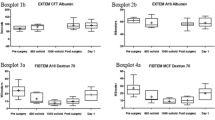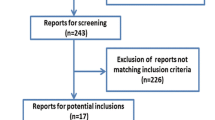Abstract
Hydroxyethyl starch (HES 450.000/0.7; Hespan 6.0 g/100 ml) was compared with standard crystalloid solutions in postoperative volume replacement in 20 patients undergoing routine orthopaedic surgery. The HES group showed no clinical evidence of haemorrhage and no laboratory evidence of significant haemostatic defects as assessed by standard coagulation tests, platelet aggregation and fibrinogen concentrations. There was a slight shortening in the thrombin time and a smaller increase in postoperative FVIII RAg and FVIII RCof levels in the HES group. HES is a safe and effective volume expander for postoperative use.
Similar content being viewed by others
References
Alexander B, Odake K, Lawler D, Swanger M (1975) Coagulation, haemostasis and plasma expanders. Fed Proc 34:1428
Austen DEG, Rhymes IL (1975) A laboratory manual of blood coagulation. Blackwell, Oxford
Biggs R (1976) Human blood coagulation haemostasis and thrombosis. Blackwell, Oxford
Born GVR (1962) Quantitative investigations into the aggregation of blood platelets. J Physiol 162:67
Brozovic M (1977) Physiological mechanisms in coagulation and fibrinolysis. Br Med Bull 33:231
Hardisty RM, Ingram GIC (1965) Bleeding disorders — investigation and management. Blackwell, Oxford
Johnson SD, Lucas CE, Gerrick SJ, Ledgerwood AM, Higgins RF (1979) Altered coagulation after albumin supplements for treatment of oligaemic shock. Arch Surg 114:379
Karlson KE, Garzon AA, Shaftan GW, Chu CJ (1967) Increased blood loss associated with administration of certain plasma expanders, dextran 75, dextran 40 and hydroxyethyl starch. Surgery 62:670
Laurell CB (1966) Quantitative estimation of proteins by electrophoresis in agarose gel containing antibodies. Anal Biochem 15:45
Lombardi R, Mannucci PM, Seghatchian MJ, Garcia V, Coppola R (1981) Alterations of factor VIII von Willebrand factor in clinical conditions associated with an increase in its plasma concentration. Brit J Haematol 49:61
Mishler JM (1982) Pharmacology of hydroxyethyl starch. Use in therapy and blood banking, Oxford University Press, New York Oxford
Mishler JM (1984) Synthetic plasma volume expanders — their pharmacology, safety and clinical efficacy. Clin Haematol 13:75
Muzaffar TZ, Stalker AL, Bryce WAJ, Dhall DP (1972) Dextrans and fibrin morphology. Nature 238:288
Odegaard OR, Lie M, Abildgaard U (1975) Heparin cofactor activity measured with an amidolytic method. Thromb Res 6:287
Puri VK, Paidipaty B, White L (1981) Hydroxyethyl starch for resuscitation of patients with hypovolaemia and shock. Crit Care Med 9:833
Stump DC, Strauss RG, Henriksen RA, Zaleski A, Peterson RE (1983) Effects of hydroxyethyl starch on blood coagulation of normal males. Thromb Haemost 50:246
Weiss HJ, Hoyer LW, Rickles FR, Varma A, Rogers J (1983) Quantitative assay for a plasma factor deficient in von Willebrand's disease that is necessary for platelet aggregation. J Clin Invest 52:2708
Author information
Authors and Affiliations
Rights and permissions
About this article
Cite this article
Macintyre, E., Mackie, I.J., Ho, D. et al. The haemostatic effects of hydroxyethyl starch (HES) used as a volume expander. Intensive Care Med 11, 300–303 (1985). https://doi.org/10.1007/BF00273540
Accepted:
Issue Date:
DOI: https://doi.org/10.1007/BF00273540




